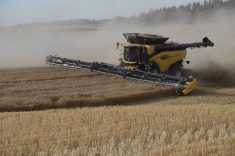Cloud-based software developers face a dilemma when trying to crack the agricultural market.
On one hand, integrating all the on-farm data they can gather with government systems, equipment manufacturers and other software companies could help farmers manage productivity and make decisions easier.
On the other hand, farmers worry that those same developers might turn the richness of data against them.
Losing ownership of their data is the biggest reason that farmers hesitate to sign up for cloud-based software solutions, attendees heard at Manitoba Ag Days.
Read Also

New Alberta funding for program hopes to further unlock agritourism industry in province
Alberta Farm Fresh Producers Association is launching a new initiative thanks to $300,000 of provincial funding to bolster Alberta’s smaller scale family farms and agritourism sector.
“You have to be able to trust that once you put your data out there in the cloud, you aren’t losing control over it,” said Darcy Herauf, director of the AgExpert division at Farm Credit Canada.
“And although we treat it like it’s your data and we provide a safe, secure vault to store your data, you’re still putting it in the cloud; you’re losing some control over it. And when you share that with another company, you’re losing a little bit more feeling of control.”
In 2018, FCC made its first jump to the cloud with AgExpert Field (AE Field), a full field management package. That same year, AgExpert became the first Canadian software company to receive the Ag Data Transparent (ADT) Seal of Approval.
ADT is a non-profit organization that evaluates and verifies that ag tech companies follow basic guidelines when collecting, using, storing and transferring farmers’ agricultural data.
“We believe that farmers own their data. Neither Farm Credit (Canada) nor AgExpert makes any claims to farms’ individual data sets,” said Herauf. “We want to make sure that they can control who they share (with). We make it as easy to not share their data as it is to share it. We really want that control in the hands of our customers.”
It’s the reason FCC pushed to bring ADT certification to Canada, Herauf added. It hoped that, with ADT on the landscape, the sector could build “a whole ecosystem based on that trust certification.”
In 2019, AgExpert brought its farm accounting software, AgExpert Accounting (AE Accounting), to the cloud.
“The easiest way to remember what AE Accounting is, is to think of it as QuickBooks, built specifically for Canadian agriculture,” said Herauf. “Anything that a farm needs to manage (in) the financial aspects of their operation can be done in AE Accounting.”
The software is designed to work with AE Field, which Herauf flagged for its ability to help farmers keep tabs on their cost of production.
“By digitizing every pass or every activity you do on that field throughout the growing season, (AE Field) can start tracking your in-season cost of production to help marry those in-season agronomy decisions with financial decisions,” he said.
Some of the promised benefits of cloud-based programs are similiar in agriculture to those in other sectors: they are convenient, keep material in one spot, and provide peace of mind that comes with redundancy. Information is no longer tied to one place so it is not susceptible to fires, floods or local network computer glitches.
“Having it in the cloud means it’s always available and it’s always backed up. We have two copies of everything,” said Herauf.
But the most significant benefits arise when farm data is connected with other data sets. That’s done through APIs, or application program interfaces.
“APIs allow different systems to talk to each other,” Herauf said. “That’s what really makes it easy for our customers to be able to share their data. We have partnerships with lots of other ag-tech companies that other Canadian farmers are using under the principle of ‘enter data once in any system and use it multiple times.’”
Techies get excited about opportunities for a high level of connection, but that’s also where trust issues get serious. Even so, that’s where the technology is headed, said Herauf. The trend is toward integration, despite concerns over data ownership and control.
Rather than manually entering data, machines track it and send it to the cloud as it’s gathered.
“So I can bring that data from my machine into AE Accounting, share it with an insurance provider, and share it with whoever without having to do a lot of manual data entry,” said Herauf. “We think that’s the future.”
The integration between farmers, food processors and ag-tech companies is well underway at AgExpert. The company has integrated its platform with John Deere’s My Ops Centre farm management system, so that information gathered by machinery can be shared with AE Field.
AgExpert launched a similar integration with Climate FieldView’s digital farming platform last summer and also has an integration agreement with McCain Foods.
“If you are a potato producer and you are using AE Field to track the field activities, we’re using that data to help populate CanadaGAP forms and PSA forms,” said Herauf, referencing programs meant to record farm practices and track farm sustainability.
“Our integration with McCain now takes that data right from AE Field and puts it right into the McCain system. This makes it smooth and relatively painless for all of our customers.”
In March, AgExpert hopes to launch an integration with hail insurance provider Palliser Insurance, headquartered in Saskatoon.
“If you need to apply for hail insurance, you have to manually re-enter all of that data in the system just to get a quote (right now),” said Herauf. “If you have 30, 40 or 50 fields, not only is it a lot of time, it’s a lot of chance for error. With our integration, it’s three clicks of a button, and you can bring in information from AE Field.”
Other tech integrations on the horizon include OCR invoice and receipt data extraction with Quebec-based Aleop, transactional data collection with the financial services company PLAID and input costing through AgConnexion.
Herauf said it’s about making life easier for farmers.
“We think it’s really important to help farmers make better decisions or optimize that decision making process.”















